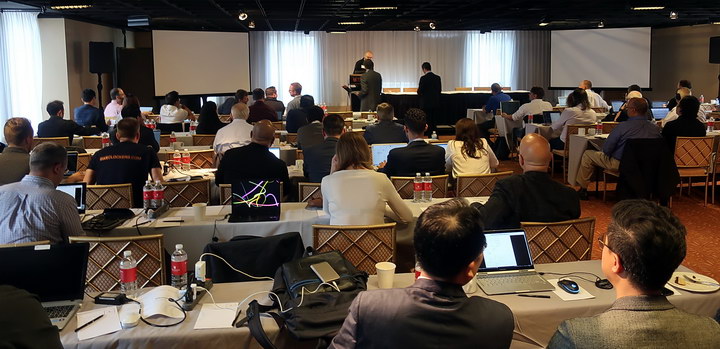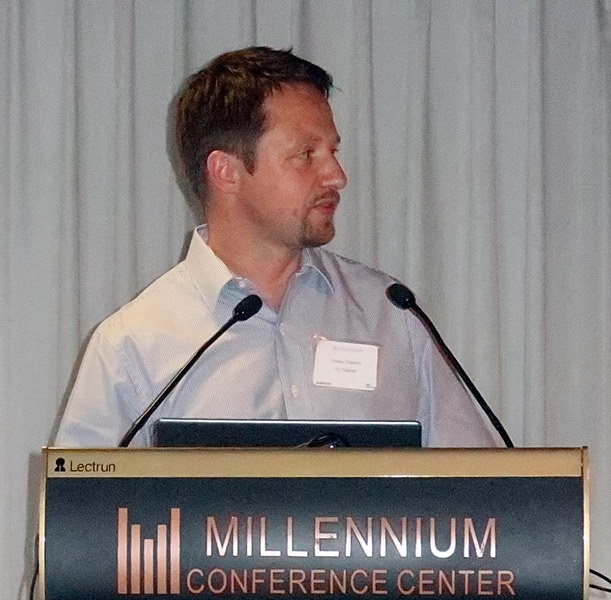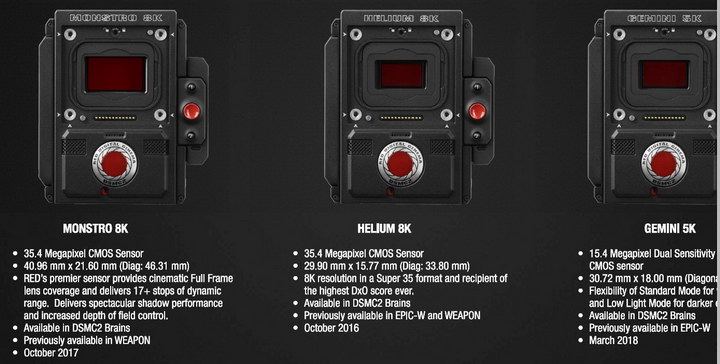NEWS
Production Of 8K Content For 8K TVs
June 19, 2019
On June 11th, the 8K Display Summit was held in New York at the Millennium Times Square Hotel. The event was produced by Display Daily regular, Chris Chinnock of Insight Media, and sponsored by Samsung. One of the topics discussed in detail by three of the 14 total speakers was 8K content creation. Other speakers also touched on content creation as part of the whole 8K (UHD-2) ecosystem.
 The 8K Display Summit on June 11th had about 65 attendees from industry and the press. (Credit: M. Brennesholtz)
The 8K Display Summit on June 11th had about 65 attendees from industry and the press. (Credit: M. Brennesholtz)
Everyone at the 8K Display Summit agreed that the value of 8K was in the very-high image quality an 8K TV showing native 8K content could show. They agreed this high image quality came not just from more pixels (7680 x 4320), but from all the other “Better Pixel” ideas that need to be incorporated in 8K video. These better pixel ideas include wide color gamut (WCG), high dynamic range (HDR), higher bit depth and high frame rate (HFR).
Generally these pixel improvements, except for HFR, are being incorporated into 4K (UHD-1) content creation as well. HFR is not being implemented in 4K video because of the very high bit rates it would require. This would make 4K not backward compatible with the existing infrastructure, such as Blu Ray discs. With 8K having 4x the pixel count of 4K, this problem is multiplied and becomes very serious. For example, uncompressed 8K/120 video would have 16x the bit rate of uncompressed 4K/30 or 64x the bit rate of uncompressed FHD (1920 x 1080) at 30Hz.
Mauricio Alvarez-Mesa, CEO of Spin Digital, looked at existing human factors studies and recommended a minimum of 85 MB/s for broadcast quality 8K video compressed with HEVC (H.265). Of course, highly compressed 8K video for streaming is going to have a much lower bit rate than that but will still require a higher bit rate than 4K or FHD. However, the tools to get this many bits to the consumer such as 5G technology and ATSC 3.0 are, in fact, available or under advanced development today and should be fully developed by the time the public is ready for 8K content for their 8K TVs.
Where will this content come from? Is the content creation ecosystem ready to produce 8K content? Right now, most of the 8K content available seems to be test and demo material. Three speakers were dedicated to the 8K production issue:
- Florian Friedrich, Principal of FF Pictures GmbH, spoke on “8K Production DO’s and DON’Ts.”
- Dan Duran from Red Digital Cinema spoke on “Red 8K Workflow With Real-Time Nvidia GPU Acceleration.”
- Phil Holland (PHFX), an independent cinematographer and director, spoke on “How I’ve Been Exploring 8K.”
 Florian Friedrich speaking at the 8K Display Summit (Credit: M. Brennesholtz)
Florian Friedrich speaking at the 8K Display Summit (Credit: M. Brennesholtz)
Florian Friedrich talked about types of content that are especially suited for the 8K treatment. These included special events, weddings, crowded places, landscapes, portraits, macros and product shots. Other types of content are not really appropriate for 8K acquisition and distribution, including run and gun content and content that needs to be shot at a high ISO setting on the camera. He added that almost any content looks better if it is shot on an 8K camera, even if it is intended to be released eventually in 4K. This is a point mentioned by several other speakers at the 8K Display Summit: whenever possible, capture content at a higher resolution than the intended resolution of the eventual master. Not only does this eliminate certain types of artifacts in the final image but it allows flexible crops of content without loss of resolution.
Cameras he suggested as being suited for 8K acquisition included the Red Dragon, Monstro and Helium; the ARRI Alexa LF and Alexa 65; the Sony Venice and F65; and the Ikegami/NHK 8K camera. The Panavision Millennium DXL camera should also be added to his list. He said cameras to avoid were consumer-grade 4K cameras or any camera that recorded in a 4:2:0 format. Lenses to go with the cameras need to be tested on 8K test patterns. When choosing a camera for an 8K project, Friedrich warned never to forget 8K is married to HDR and to make sure the camera had sufficient dynamic range to make good HDR content.
Cameras need to be on stable, vibration-free platforms. Lenses, if possible, should be used in their sweet-spots, typically T5.6 – T11. Focus of these lenses when acquiring 8K content is critical and should always be done on a monitor with 1:1 pixel mapping to ensure accurate focus.
Motion blur is a major problem for video, especially high-resolution content intended to eventually be 24 frames per second cinema content. Motion blur depends on the shutter settings of the camera and the frame rate. Even with HFR capture, and not all 8K is captured at HFR, motion blur can be a serious problem. Friedrich recommends following the ASC guidelines for minimizing motion blur and avoiding fast pans or zooms.
One thing Friedrich’s company supplies is post-production software for pre-release evaluation and editing of 8K HDR and WCG content. One example he gave of the application of this software was the elimination of jagged lines where the content should really be straight or smoothly curved. These jagged lines can be seen in virtually all content, regardless of resolution, when it is examined closely enough. It is particularly a problem if the content resolution is scaled to the nominal 1 arc-minute resolution of the human eye. Even if pixels themselves are not visible to the viewer, the jaggies (saw-tooth edges of transitions between light and dark) due to the pixels can be visible. He used the moon as an example. It subtends about 1 degree, as seen from earth by the unaided eye. Therefore, in theory, it can be represented by an image of about 64 x 64 pixels. If this is done without consideration of jaggies, they become visible. In the original of this image shown at the 8K Display Summit, it was obvious the edge between the moon and the dark background was not a smooth curve although this effect is not fully visible in this image. In any event, using the proper software, e.g. the HDRmaster Toolset from FF Pictures GmbH, can reduce or eliminate this problem. It can also do other things like generate the metadata needed for HDR content encoded with the PQ EOTF and evaluate the color gamut of the content compared to the target color gamut.
 Sensors from Red suited for the acquisition of 8K content. (Credit: Red Digital Cinema)
Sensors from Red suited for the acquisition of 8K content. (Credit: Red Digital Cinema)
Dan Duran discussed cameras from Red Digital Cinema suited for 8K acquisition. Red has three image sensors that can be used for this, the Monstro 8K, the Helikum 8K and the Gemini 5K. Each of these sensors has been used in more than one Red camera. Since Red cameras are largely modular, two cameras with the same sensor can have quite different accessories attached to them.
The Monstro 8K would be the choice for 8K acquisition, if the movie’s budget supported it. Not only is it a true 8K sensor, it is large enough to cover a cinematic full frame lens. For HDR, and HDR is (or should be) always coupled to 8K, it offers 17+ stops of dynamic range.
 Images acquired at 8K can be cropped in post-production to 4K without loss of resolution. (Credit: Red Digital Cinema)
Images acquired at 8K can be cropped in post-production to 4K without loss of resolution. (Credit: Red Digital Cinema)
Cinematographer Phil Holland’s opinion of 8K? “Pretty cool,” he told us. He did his first 8K project in 2015 and since then about 90% of his projects have been either 4K or 8K. He said 8K content must not be upscaled from a low resolution source such as FHD (1920 x 1080). He said that, ideally, 8K content should be acquired at greater than 8K and then downscaled to 4K or 8K in the master. He talked about these higher resolutions as being “moving photographs.”
My opinion of 8K? “Gorgeous.” There was sample 8K content both at the 8K Display Summit and later that week at the CE Week event. Several years ago, when 4K was first being demonstrated at events like these, the 4K content shown was typically very slow pans of quaint villages with lots and lots of detail but little or no action. The 8K demos I saw included action sequences, including some from the 2018 movie Robin Hood that had been acquired at 8K. This demo material with action looked very good except for a few scenes where motion artifacts were visible. I asked, and the demo material was done at 60 frames per second, not 30 or 24. This implied a very high data rate for the 8K content. I wonder if the few artifacts I saw would have gone away if the content had been truly HFR at 120 frames per second, adding another 2x to the data rate.
Other than camera acquisition and computer-generated images, other speakers at the 8K Display Summit and CE Week discussed two sources of 8K images that are available today. First is cinema content originally shot on 65mm or 70mm film. This film contains enough resolution to justify rescanning and remastering the films at 8K. Most IMax movies were shot on 70mm film and several other recent films were shot on 65mm, 70mm or a combination of the two. A few of the recent films shot this way include Quentin Tarantino's The Hateful Eight (2015), Christopher Nolan's Dunkirk (2017), and Kenneth Branagh's Murder on the Orient Express(2017). In addition, several classic films were shot on 65mm film, including Ben-Hur (1959), Mutiny on the Bounty (1962) and It's a Mad, Mad, Mad, Mad World (1963).
The other relatively available source of 8K images? It may just be the phone or camera in your pocket. If it has more than 8Mpixel resolution, you probably have never seen the still photos you have taken at full resolution. If it has 20Mpixel resolution, you almost certainly have never seen the pictures at full resolution because that’s more than a 4K display can show, but you would see everything on an 8K TV. This is seen by some as a source of 8K content to drive consumer acceptance of 8K TVs. –Matthew Brennesholtz

 then "Add to Home Screen"
then "Add to Home Screen"